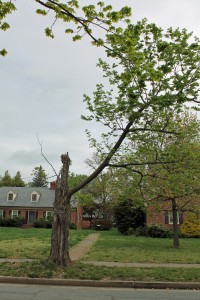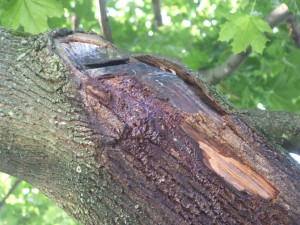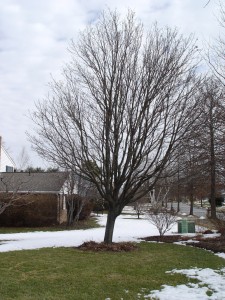When to Get Rid of a Tree?
November 3rd, 2015
This may be an inhospitable thing to ask after trees have given us such a colorful, season-ending sendoff, but how can you tell when it’s time to ax a tree?
It’s a tough call for a lot of people, and it’s something I get asked a lot during my Garden House-Calls travels.
For some people, losing an old tree is like losing an old friend. It’s a particularly hard decision when the tree has sentimental value, such as one the kids brought home when they were little or one that dear old dad planted as a house-warming present decades ago.
No wonder those are hard to remove until every last leaf and branch is dead.
Yet like people, the time comes in every tree’s life when it slips into twilight and beyond – assuming it doesn’t meet an abrupt demise during a storm or at the end of a rabbit’s bark-girdling teeth.
Sometimes a tree gives warning that the end is approaching, like my one-time ‘Prairifire’ crabapple that began showing smaller leaves and dying branches for two years before failing to leaf out.
Some trees limp along for many years in a hang-on state.
Others look reasonably good on the outside while hiding troubles inside or beneath, only to seemingly die “overnight.”
Evergreens are particular fakeouts because they can be functionally root-dead for weeks before suddenly turning brown. Think about how a cut Christmas tree looks green and alive for weeks even after it has been totally disconnected from its roots.
If dwindling looks were the only consideration, the cut-or-no-cut decision would be easier. But the problem is that failing trees are more at risk of coming down at any time – even without a precipitating storm.
When a target such as a house, car or person is in the way, that’s a real problem. Falling trees can crush roofs and cars, knock out power lines, and even kill people.
It’s not a threat to take lightly. I don’t mention this to scare you into getting out the chainsaw but rather to suggest that it’s a good idea to pay attention to your trees, if you haven’t done that lately.
It’s impossible to say for sure when a tree is about to come down, but there are signs.
The most obvious is when a tree is dead. Evergreens that have gone totally bare and leafy trees that don’t leaf out any more are goners that can be verified by bending a few branches.
Live (or “newly dead”) branches will be somewhat pliable and bend while dead ones are brittle and will snap under pressure.
Scrape off a little of the bark and you’ll also get a clue from what color is underneath. Green is good, brown is bad.
A dead tree might not drop tomorrow, but it’s just a matter of time until it does. If there’s a target within range of one of these, get its removal to the top of your to-do list.
Trees in trouble are a little harder to assess because some issues are temporary and non-fatal stressors while others are the beginning of a slide toward death.
You may need to hire a certified arborist or similar tree expert to help you make the call – again, especially if it’s a big tree and there’s a target nearby.
Some things to look for:
* Leaf issues. Stressed and possibly failing trees usually produce smaller-than-usual leaves or turn color early in fall or drop their leaves unusually early. This could be a one-season setback related to weather, but it’s also often a first sign of trouble.
* Dead or dropping limbs. A few small droppers here and there usually aren’t a serious threat, but when more and more are coming down or bigger and bigger ones are dropping, that’s more worrisome. Note: Remove any “hangers” that got snapped off in a storm that are larger than 1 inch in diameter.
* Dieback. Dying sections of trees are usually a sign that the whole tree is failing.
* Forked trunks. A tree with two or more large upright limbs shaped like a “V” is prone to split down the middle, especially during a snow, ice or wind storm. The sooner you notice that developing and can do corrective pruning, the better.
* Signs of decay. Sunken soft spots, cracks in the trunk, fungal growths and wounds with seeping liquid are signs that decay may be occurring. Trees often can heal small wounds, but if you’re seeing the wound grow or multiple defects occurring, the tree is heading downhill.
* Leaning trees. Crooked trees are not necessarily a hazard, but ones that have recently begun leaning – especially if you see that the roots are now exposed – are losing their support. That’s a problem.
* Root decay. Are mushroom-like growths appearing around the base of the tree or out of the ground nearby? Those are most likely root-rotting fungi and a sign of increasing trouble.
Sometimes trees in trouble can be helped, but the first step is to determine an accurate diagnosis. Without that, you’re just guessing and likely to waste money on useless or counter-productive measures, such as trying to fertilize away a bug problem (you’ll likely make that worse) or adding water to a tree that’s suffering from root-rot (a good way to hasten death).
Sometimes a tree isn’t so much a hazard as just plain ugly.
Maybe it’s been neglected or allowed to grow in malformed ways. Maybe it’s plagued by non-fatal but beauty-ruining bugs or disease. Or maybe wind or ice storms have split off enough major branches that the tree is crying out for Dr. Kevorkian.
In this case, ask yourself, “Is it worth paying for spray treatments every year for a so-so tree?” or “Has the tree become more of an eyesore than an asset?”
If compelling sentimental reasons don’t outweigh aesthetics, it may be time to think chainsaw.
Then you’ll have space to replant with something better.










